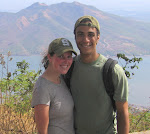Comayagua, Honduras. The one time head of government in Honduras and the eternal seat of Honduran culture, Comayagua is, culturally speaking, the heart of the country during Semana Santa, Holy Week. Of course, across the North coast of the country exist a plethora of beaches and resorts, both of which are popular choices for many during Semana Santa. Yet, for some good ol’ fashioned cultural, ecumenical fun, Comayagua’s the choice.
The cathedral and numerous colonial era churches found there are starkly beautiful in their scorching desert ambience, surrounded in the distance by imposing mountains that have yet to be broached by the city limits, and within the city, by shade providing tropical trees. Witnessing the hordes of churchgoers during Semana Santa is a reminder that Honduras is most definitely not a secular nation. Whether Catholic or Evangelical, the vast majority of people are Christians, many of whom consider it a life long ritual to entirely set aside their ordinary lives in remembrance of Jesus during Semana Santa.
Along with thousands of Hondurans, foreign tourists, and expatriates we observed and took part in many of the rich traditions Comayagua is so well known for. From attending an evening church service in the cathedral to touring Comayagua’s colonial museum and house of culture, known for artifacts of not only local but also national and international interest, to viewing the world famous alfombras, or carpets, that are artfully and painstakingly created on the city’s streets, we saw a great deal and, to be humble and honest, left a great deal unseen as well. We felt as if we were discovering something new, and yet transcendent, as we visited the museum and house of culture and viewed the alfombras being built (a process that lasts some 12 hours). The irony of our trip was that what we experienced as new and transcendent (so much timeless culture expressed with such potency, beauty, and precision) was soon to disappear, forever.
Every year the procession of Christ carrying the cross travels through the heart of the colonial capital, tramples and quickly destroys the several dozen ornately decorated carpets, which are displayed on temporarily blocked off streets throughout downtown. We knew to expect the destruction of the carpets, which are made of multicolored sawdust and tediously arranged on the processional route because, after all, they are delicate and made to be unmade. What no one expected was the disappearance of the museum and house of culture, which went up in flames only a few days ago, less than a week after we stood there, marveling at wooden masks, colonial era priestly garb, priceless jewelry, and precious documents from the lives of Honduras’ heroes. As an interesting aside, the word “héroe” (hero) is only used with reference to those who have physically fought on behalf of the nation. There is another word, commonly used and clearly distinct from héroe, used for the nations ideological and intellectual warriors, “prócer”. No one yet knows what caused the blaze but it’s plausible that the 100 + temperatures that have hovered over Comayagua recently caused a gas tank explosion. There’s also talk of an electrical fire.
We may never know what started the blaze, and I’m not sure it much matters. What we do know is that all that is transcendent, that quality we so appreciate about the many intangible beauties wrapped up in culture, for instance, is never truly encapsulated in what we can touch, but rather must be remembered by and enshrined in our senses. As we watched Christ bearing his cross through the streets – albeit a highly fantastical plastic Christ – little did we know how well that great life, ended over 2,000 years ago now, would so potently remind us of the present.
Artifacts are but stubborn things (albeit, artfully and painstakingly created beautiful things of historic value) that have yet to hand over the reigns to eternity. In a sense we mourn with the city of Comayagua – it lost a great deal in that fire. We also recognize that if a plastic figurine can duly remind us of the life of Christ, lived and terminated in a time so long ago that human civilization had better philosophized about what heaven consisted of than it had understood the basic shape of the earth, whatever was great about what was burnt in Comayagua will not disappear, but rather must take a new form. We left the city on the eve of the creation of transcendence.
Sunday, April 19, 2009
Subscribe to:
Post Comments (Atom)

No comments:
Post a Comment